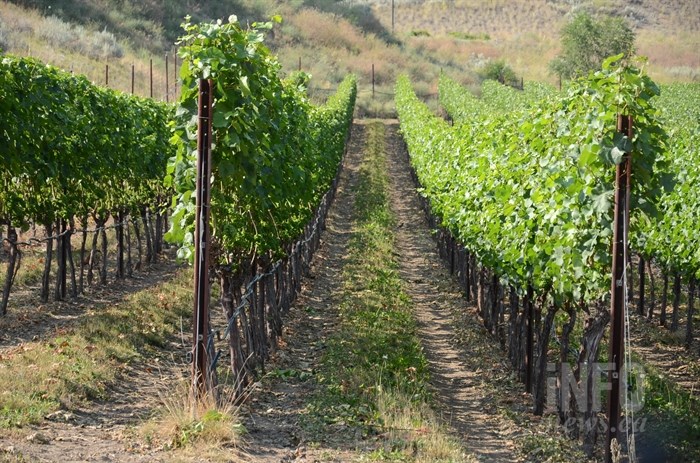Climate change forcing Okanagan wine industry to remake itself

It has been almost 30 years since a major trade agreement forced the Okanagan wine industry to re-invent itself.
Now, climate change is forcing a second wave of re-invention, albeit not nearly as drastic.
“When NAFTA (North American Free Trade Agreement) first went through, everyone thought suddenly good wine can be imported and not have to pay tariffs so we’re going to have to update,” Miles Prodan, president and CEO of Wine Growers BC, told iNFOnews.ca. “So, we tore out a whole bunch of our grapes. Ironically, we tore out the grapes that were good at mitigating cold. But they didn’t make good wine.”
NAFTA was implemented in January 1994 and led to two-thirds of the grapes in Okanagan vineyards being ripped out and replaced with quality “vinifera” grapes.
That transformed the industry into a high quality, internationally recognized VQA (Vintners Quality Assurance) industry.
The industry boomed and total acreage grew.
But, largely due to climate change in recent years, the grape tonnage dropped by 32%, falling to 20,000 tons in 2021 from 30,000 just three years earlier. That represents a drop to 3.1 tons/acre from 4.6 tons/acre, according to the Wine Growers of BCs 2021 BC Vineyard Resilience Report
Of course, 2021 was when the “heat dome” hit, smashing regional heat records, which was not good for grapes.
READ MORE: One more day of the heat wave pushes Okanagan and Canadian records even higher
The report lists four climate change factors.
Rising average temperatures had a small positive impact but extreme heat (the number of days that exceed 32 Celsius), extreme cold and lower levels of precipitation each had large negative impacts, it says.
In December 2022, a cold snap hit so hard that some varieties may produce virtually no grapes this year and many plants may have actually been killed.
READ MORE: Devastating grape freeze expected to hammer wineries in the Okanagan
The full impact of that damage won’t be known for a couple of weeks since the plants have yet to bud due to the cool spring in the region.
The Okanagan, which has 86% of the province’s vineyards, has been the hardest hit in recent years by climate change but the industry as a whole is looking at making significant changes in the ways wines go to market.
“We’re still young,” Derek Kontkanen, chair of the six-member committee looking into making changes, told iNFOnews.ca. “We’re learning more about the region and the area. When we first planted, maybe we didn’t plant the right varieties on the right sites.”
Kontkanens is director of wine making for Arterra Wines but spoke only as chair of the Wine Advisory Industry Committee.
“There needs to be a bit more of a shift,” he said.
The VQA standards were formally adopted in 2008 and there have been some amendments made over the years.
Given the impact of climate change, the industry would like to be more nimble since it can take a decade to recommend changes, get them approved, replant and get a crop.
“We’re looking at how to speed that up so people can do experiments on how to grow grapes in different varieties and in different areas,” Kontkanen said.
When the regulations were put in place, only certain varieties could be grown. The committee is suggesting that list be expanded while still maintaining the high quality BC wines have already achieved.
That would allow for hardier varieties but also open new regions, like the Lillooet or Kamloops areas, to bring in hardier vines that can cope with their colder winters.
All VQA wines have to be made from 100% BC grapes but there are subregions in the province so, in order to quality as an Okanagan VQA wine, only 5% of the juice can come from outside the region.
Given the small crop expected in the Okanagan this year, wineries won’t be able to make much for that loss of product from the Fraser Valley, Vancouver Island or even the Similkameen, if they have bumper crops.
The suggestion is to allow up to 15% of grapes to come from outside the region, but still in BC. Other wine producing areas, like Washington, California, New Zealand, Australia and Ontario allow 15%, Kontkanen said.
Changes to amelioration rules are also being looked at in light of dramatically warmer summers in the Okanagan.
“As we get warmer and grapes ripen quicker, your sugar level increases very quickly,” Kontkanen said. “Your phenolic ripeness – which is your tannins, your fruit flavours and all those good things that make a great wine – don’t ripen at the same rate as the sugar, so your sugar level may be really high. You may end up with a wine that’s 16% alcohol.
“Amelioration allows you to do a small addition of water or acid back to the juice to lower the Brix by a certain amount to facilitate fermentation but to also bring the wine more in balance.”
Brix is the term used for measuring the sugar content.
The fourth change calls for a wider range of packaging to keep up with trends in the industry.
Other countries allow quality wine to be sold in boxes, cans or single service containers. VQA wines are restricted to standard sized glass bottles.
The industry is lobbying government for a replant program to assist in replanting varieties that better fit their location.
For example, Merlot is the number one wine produced in B.C. but in the Okanagan, about 75% of that crop could disappear this year.
Pinot noir, by contrast, is much hardier but only ranks fourth by acreage in B.C.
White wine grapes are also much hardier. Pinot Gris is the number two wine by volume and is facing only a 1-20% loss this year while Gewurztraminer losses are expected to be in the 0-26% range.
Kontkanen does not liken the current situation to the crisis triggered by NAFTA 29 years ago. He says the industry just wants to get ahead of the climate change impacts.
But no changes will be made this season.
The VQA regulations reside with the BC Wine Authority and that’s the body Kontkanen and his committee will report to.
Over the next few months, association members will be sent information and asked for their opinion.
If it looks like the BC industry is in favour of the proposed changes, those will be put to a plebiscite, probably this fall.
That’s done by a “double majority” vote where 65% of the members representing at least 50% of the winery production must vote in favour.
Final changes have to be approved by the Ministry of Agriculture so the whole process could take until the end of the year.
— This article was updated at 10 a.m. Friday, April 28, 2023, to correct Miles Prodan's title.
To contact a reporter for this story, email Rob Munro or call 250-808-0143 or email the editor. You can also submit photos, videos or news tips to the newsroom and be entered to win a monthly prize draw.
We welcome your comments and opinions on our stories but play nice. We won't censor or delete comments unless they contain off-topic statements or links, unnecessary vulgarity, false facts, spam or obviously fake profiles. If you have any concerns about what you see in comments, email the editor in the link above.


